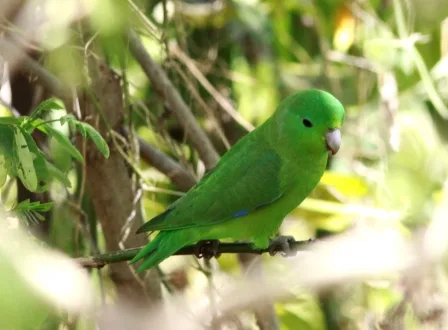
Blue-winged Parrotlet
[order] PSITTACIFORMES | [family] Psittacidae | [latin] Forpus xanthopterygius | [authority] Taczanowski, 1883 | [UK] Blue-winged Parrotlet | [FR] Toui de spix | [DE] Blauflugel-Sperlingspapagei | [ES] Catita Enana (Arg) | [NL] Spix’ Muspapegaai | [copyright picture] Elis Simpson
Subspecies
| Genus | Species | subspecies | Region | Range |
| Forpus | xanthopterygius | SA | c, se | |
| Forpus | xanthopterygius | crassirostris | se Colombia to n Peru and w Brazil | |
| Forpus | xanthopterygius | flavescens | se Peru, e Bolivia | |
| Forpus | xanthopterygius | flavissimus | ne Brazil | |
| Forpus | xanthopterygius | spengeli | n Colombia | |
| Forpus | xanthopterygius | xanthopterygius | e Brazil to Paraguay and n Argentina |
Genus
The genus Forpus consists of seven recognized species that are distributed in the lowlands of South America and Mexico. The Forpus genus is one of the few groups of parrots where females differ markedly from males. They are the smallest birds in the Psittaformes order.
Physical charateristics
F.x. xanthopterygius: male-in general olive/green to green in colour; eyes surrounded by bright green; purple/blue primary and secondary coverts; purple/blue bases to outer webs of secondary feathers; purple/blue underwing coverts, lower back and rump. Bill horn in colour with grey at base of upper mandible. Eye dark brown. Female-green instead of blue markings; green/yellow forehead and face. F.x. flavissimus: male-paler, more yellow/green; yellow/green forehead, cheeks and throat. Female-paler and more yellow/green. F.x. crassirostris: male-paler blue markings; pale gray/purple primary coverts; dark purple/blue secondary coverts; smaller in size. Female-green less yellow overall. F.x. olallae: male-as in crassirostris, but darker purple/blue wings, rump and lower back; paler underwing coverts. Female-as in crassirostris. F.x. flavescens: male-as in xanthopterygius, but yellow/green paler; green/yellow forehead, cheeks, and underparts; paler blue on lower back and rump. Female-as in xanthopterygius, but yellow/green paler. F.x. spengeli: male-blue of lower back and rump more turquoise; turquoise/blue with purple underwing coverts and axillaries. Female-as in xanthopterygius but forehead more yellow.
Listen to the sound of Blue-winged Parrotlet
[audio:https://planetofbirds.com/MASTER/PSITTACIFORMES/Psittacidae/sounds/Blue-winged Parrotlet.mp3]
Copyright remark: Most sounds derived from xeno-canto
recorded by Paul Donahue
| wingspan min.: | 0 | cm | wingspan max.: | 0 | cm |
| size min.: | 12 | cm | size max.: | 13 | cm |
| incubation min.: | 17 | days | incubation max.: | 19 | days |
| fledging min.: | 28 | days | fledging max.: | 31 | days |
| broods: | 1 | eggs min.: | 4 | ||
| eggs max.: | 7 |
Range
South America : Central, Southeast. F.x. xanthopterygius: NE Argentina in Misiones, NE Corrientes, E Chaco and E Formosa; and from Paraguay north through central and mideastern Brazil to N Bahia.
F.x. flavissimus: NE Brazil, from Maranhao, Ceara, and Paraiba south to N Bahia.
F.x. crassirostris: NE Peru, E Ecuador and SE Colombia east along both sides of Amazon River and smaller riverlets to C Amazonas, N Brazil.
F.x. olallae: found in Codajas and near Itacoatiara, on N bank of Amazon River in E Amazonas, N Brazil.
F.x. flavescens: CE Peru south to E Bolivia, in Beni and Santa Cruz.
F.x. spengeli: restricted to N Colombia, from Caribbean coastal region west and south of Santa Marta mountains, Atlantico, south along Rio Magdalena in Bolivar and Cesar.
F.x. flavissimus: NE Brazil, from Maranhao, Ceara, and Paraiba south to N Bahia.
F.x. crassirostris: NE Peru, E Ecuador and SE Colombia east along both sides of Amazon River and smaller riverlets to C Amazonas, N Brazil.
F.x. olallae: found in Codajas and near Itacoatiara, on N bank of Amazon River in E Amazonas, N Brazil.
F.x. flavescens: CE Peru south to E Bolivia, in Beni and Santa Cruz.
F.x. spengeli: restricted to N Colombia, from Caribbean coastal region west and south of Santa Marta mountains, Atlantico, south along Rio Magdalena in Bolivar and Cesar.
Habitat
Prefers drier wooded habitats such as open and riparian woodland, cerrado and caatinga; also found in savanna, palm groves, semi-arid scrubland and pastures. Found also along Amazon River in lighter riparian growth.
Reproduction
Nest is tree hole or termite nest or sometimes in uesed nest of Hornero’s. Grass is used to provide for floor bedding of the nest. The clutch size is 4-7 eggs which are incubated for about 18 days by the female only. Young leave the nest after about a month.
Feeding habits
Eats fruits of cecropia, seeds of Mikania and Trema mirantha and flowers of Ambrosia and Marcgravia. Will forage in the open and sometimes on the ground. Highly social; found in groups of up to 50 individuals.
Video Blue-winged Parrotlet
httpv://www.youtube.com/watch?v=vpxWFmR9Bz4
copyright: Ciro Albano
Conservation
This species has an extremely large range, and hence does not approach the thresholds for Vulnerable under the range size criterion (Extent of Occurrence <20,000 km2 combined with a declining or fluctuating range size, habitat extent/quality, or population size and a small number of locations or severe fragmentation). The population trend appears to be stable, and hence the species does not approach the thresholds for Vulnerable under the population trend criterion (>30% decline over ten years or three generations). The population size has not been quantified, but it is not believed to approach the thresholds for Vulnerable under the population size criterion (<10,000 mature individuals with a continuing decline estimated to be >10% in ten years or three generations, or with a specified population structure). For these reasons the species is evaluated as Least Concern.

Migration
Blue-winged Parrotlets in Argentina move seasonally as different plant communities flower, while populations in the Atlantic Forest of Brazil are altitudinal migrants.
Distribution map

